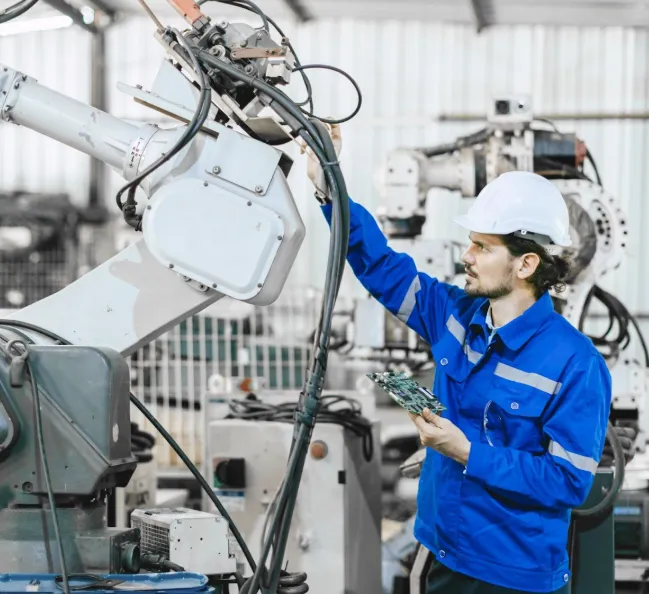The automotive industry has long been a pioneer in adopting new manufacturing technologies, from the early assembly lines that revolutionized mass production to the advanced automation seen today. At the center of this evolution are automotive robots, machines designed to streamline complex tasks, improve precision, and boost efficiency across car factories worldwide.
What Are Automotive Robots?
Automotive robots are robotic systems built to assist with various stages of vehicle production. Depending on their design, they can operate independently, collaborate with human workers, or function alongside other robotic systems. While some require close monitoring, others are fully autonomous, equipped with sensors and advanced computing that allow them to perform tasks with minimal oversight.
Different categories of robots play unique roles in the automotive sector:
- Six-axis robots provide versatility in welding, assembly, and material handling with their ability to move in multiple directions.
- Collaborative robots (cobots) are built to safely work side-by-side with humans, handling repetitive tasks that free workers for more complex responsibilities.
- SCARA robots are often used for precise assembly and placement jobs thanks to their rigid structure and efficient horizontal movements.
- Autonomous mobile robots (AMRs) transport materials within factories using onboard navigation systems and collision detection, reducing manual labor and ensuring safe, accurate deliveries.
No matter the type, these machines share a common purpose: to make automotive manufacturing faster, safer, and more reliable.
Real-World Applications of Automotive Robotics
Painting: Applying paint to vehicles is one of the most demanding steps in car production. Robots excel here by delivering consistent, even coats while minimizing overspray, ensuring a flawless finish and reducing material waste.
Machining: Many car parts are shaped through subtractive manufacturing, where robots guide CNC machines to carve components with remarkable precision. This process is both faster and more accurate than manual machining.
Welding and joining: Robotic welders can operate at high speeds with consistent quality, producing durable bonds in critical vehicle structures. They are now widely used for both traditional welding and newer joining techniques.
Assembly: Building an entire vehicle requires assembling thousands of parts. Robots take on repetitive and intricate assembly steps, such as installing components or applying adhesives, improving accuracy and reducing human error.
Hazardous materials handling: From flammable substances to corrosive chemicals, many materials in car production pose risks to humans. Robots safely manage these tasks, protecting workers while keeping production moving smoothly.
Why Robots Are Essential to Modern Car Factories
Robots are not simply add-ons to the automotive industry—they are reshaping it. Their advantages include:
- Greater efficiency: Robots complete repetitive tasks quickly and accurately, shortening production cycles.
- Consistent quality: Robotic systems deliver precision that minimizes defects and ensures uniform standards.
- Improved safety: By handling dangerous jobs, robots protect human workers from injury and exposure to harmful substances.
- Lower costs: Automation reduces waste, labor expenses, and rework, offering long-term savings.
- Adaptability: Robots can be reprogrammed for new tasks, giving manufacturers flexibility in meeting shifting demands.
- Higher output: With 24/7 operation, robots enable plants to increase capacity without sacrificing quality.
- Smarter processes: Many robots collect and analyze data, helping manufacturers optimize workflows and make informed decisions.
- Traceability: Robotic systems support consistent processes that enhance compliance and product tracking.
The Technology Behind the Machines
At the core of every automotive robot lies sophisticated software. These programs control movements, enable communication with other machines, and ensure efficient performance. Developing custom software for each robotic task can be time-consuming, but software development kits (SDKs) now make this process faster and more accessible.
SDKs offer tools for:
- Simulation and visualization, allowing engineers to test robot movements and detect potential issues before deployment.
- Path optimization, which helps robots follow efficient, safe routes that reduce energy use and cycle times.
- Interoperability, ensuring different systems within a plant can work together seamlessly, creating a connected and coordinated manufacturing environment.
The Road Ahead
As robotics technology advances, its role in the automotive industry will only deepen. From assembly lines to final inspections, robots are reshaping every stage of production. For manufacturers, adopting these innovations means faster operations, safer workplaces, and vehicles built with higher precision. The factories of the future are already here—and they are powered by robots.







